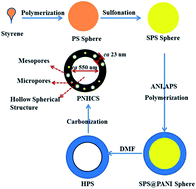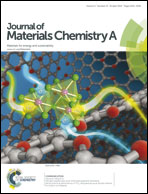Porous nitrogen-doped hollow carbon spheres derived from polyaniline for high performance supercapacitors
Abstract
Porous nitrogen-doped hollow carbon spheres (PNHCS) had been prepared by pyrolysis of hollow polyaniline spheres (HPS), which were synthesized by the use of sulfonated polystyrene spheres (SPS) as a hard template. PNHCS have a specific surface area of 213 m2 g−1 and a pore volume of 0.24 cm3 g−1. At a current density of 0.5 A g−1, the specific capacitance of the PNHCS prepared is ca. 213 F g−1. The capacity retention after 5000 charge/discharge cycles at a current density of 1 A g−1 is more than 91%. The enhanced electrochemical performance can be attributed to the unique carbon nanostructure and nitrogen-doping of the PNHCS electrodes. The hollow macro-structure plays the role of an “ion-buffering” reservoir. The micropores of the PNHCS enlarge the specific surface area, while the mesopores offer larger channels for liquid electrolyte penetration. Nitrogen groups in the PNHCS not only improve the wettability of the carbon surface, but also enhance the capacitance by addition of a pseudocapacitive redox process.

- This article is part of the themed collection: JMC A Top Picks web collection: Advances in supercapacitors

 Please wait while we load your content...
Please wait while we load your content...